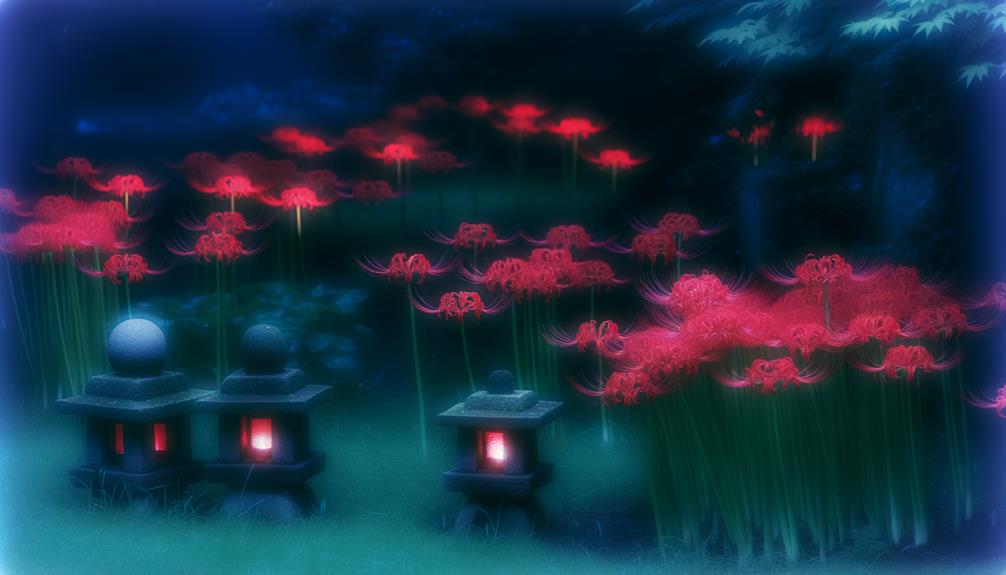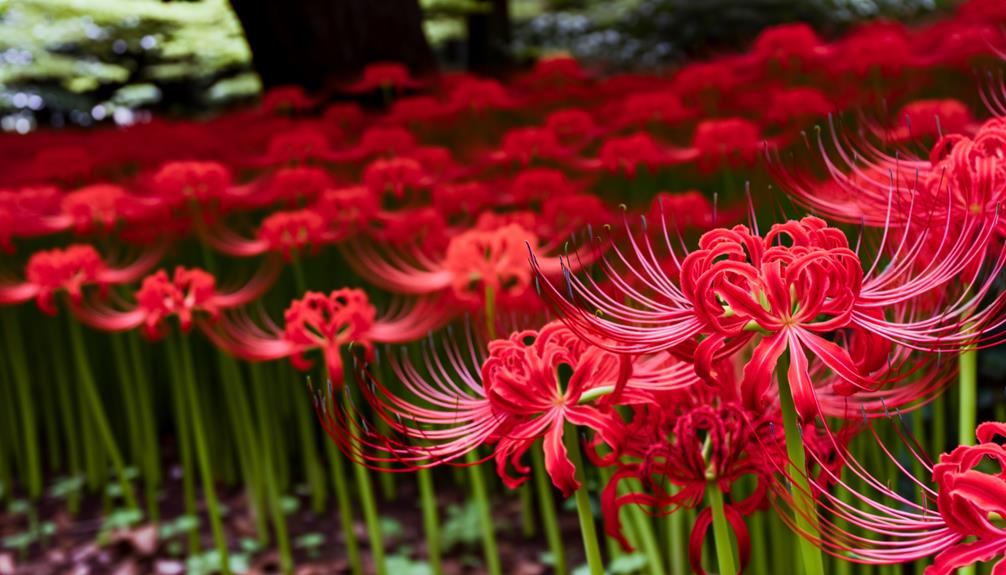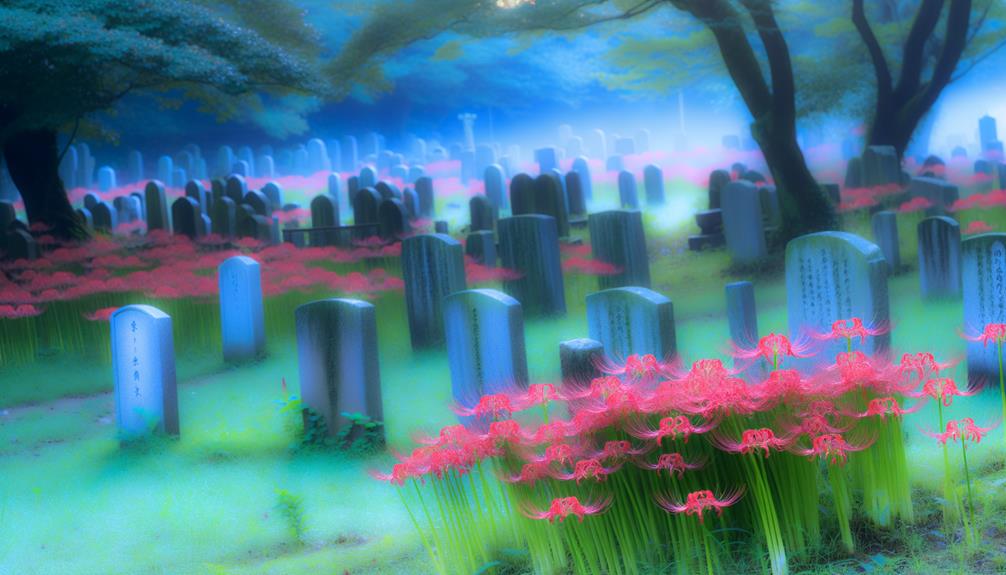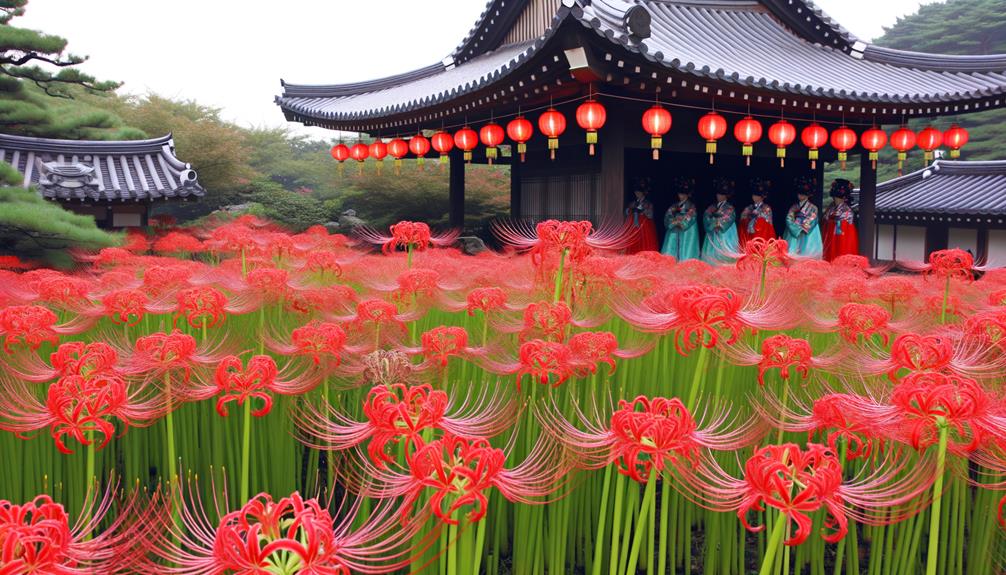Red Spider Lily Meaning Spiritual: Farewell and Rebirth
The Red Spider Lily, known for its striking red petals, carries deep spiritual significance. Across various cultures, it symbolizes the bridge between life and death, emphasizing the cycle of rebirth and the ephemeral nature of existence.
In Japan, the flower, called ‘Higanbana,’ blooms near cemeteries, embodying loss, separation, and the return of spirits during the autumnal equinox. In Buddhist traditions, it represents spiritual transformation and enlightenment, urging mindfulness and acceptance of change.
This mystical flower continues to inspire contemplation of life’s transient beauty and invites deeper exploration into its symbolic messages.

Red Spider Lily Spiritual Meaning: Farewell, Rebirth, and Soul Connections
| Symbol | Spiritual Meaning | Description |
|---|---|---|
| 🌺 Red Color | Passion & Transition | Represents intense emotions, transformation, and endings |
| 🕸️ Spider Shape | Life’s Web | Reflects destiny, fate, and spiritual interconnection |
| 🌅 Seasonal Bloom | Rebirth | Often blooms during transitions, symbolizing renewal after loss |
| 👋 Farewell Flower | Letting Go | Associated with goodbyes, especially to souls of the departed |
| 💫 Soul Connection | Eternal Bonds | Seen as a symbol of love and spiritual ties beyond this life |
Historical Background

Emerging from the annals of ancient folklore, the red spider lily carries a rich tapestry of historical significance that spans across various cultures.
This enigmatic flower, often found in Asian mythologies, is imbued with deep-rooted meanings and legends. In Chinese culture, it is believed to be a mystical bridge between the worlds of the living and the dead, symbolizing the ephemeral nature of life.
In Buddhist traditions, the red spider lily is associated with the cycle of rebirth and the transient beauty of existence. Its striking red hue and unique morphology have inspired countless tales and spiritual reflections, rendering it a symbol of both beauty and impermanence.
Through these narratives, the red spider lily continues to evoke awe and introspection.
Symbolism in Japan
In Japan, the red spider lily, known as ‘Higanbana,’ takes on profound symbolic meanings deeply connected to themes of loss, separation, and the spiritual journey.
This striking flower often blooms near cemeteries and along pathways, symbolizing a poignant reminder of the transient nature of life and the inevitability of parting. Its vivid, crimson hue evokes a sense of both beauty and melancholy, reflecting the delicate balance between life and death.
Higanbana is associated with the autumnal equinox, a time when spirits are believed to return to the earthly domain. Therefore, it serves as a bridge between the living and the departed, encouraging contemplation and acceptance of life’s impermanence.
This symbolism profoundly resonates within Japanese culture, inviting introspection and spiritual awareness.
Role in Buddhism

The red spider lily holds significant spiritual symbolism in Buddhism, often representing the cycle of rebirth and the path to enlightenment.
This vibrant flower is thought to bloom on the banks of the Sanzu River, which souls must cross to reach the afterlife. Its radiant red petals serve as a beacon, guiding spirits towards their next existence.
In Buddhist teachings, the red spider lily emphasizes impermanence and the fleeting nature of life, reminding practitioners to embrace each moment with mindfulness.
As a symbol of spiritual transformation, the flower encourages a deeper understanding of life’s impermanence and the continuous journey towards enlightenment.
This profound significance inspires practitioners to cultivate compassion and wisdom on their spiritual path.
Folklore Myths
Across various cultures, the red spider lily is steeped in folklore myths that weave tales of love, loss, and the ethereal connection between life and death.
In Japanese lore, the flower is often associated with the parting of lovers, symbolizing both the beauty and the sorrow of farewells.
Chinese myths echo similar themes, where the red spider lily is believed to guide the souls of the dead to reincarnation.
Korean legends tell of the flower blooming along paths to the underworld, marking the journey to the afterlife.
These timeless stories imbue the red spider lily with a sense of mystical reverence, reflecting humanity’s deep-seated need to find meaning in the cycles of existence.
Death and Rebirth

As these myths suggest, the red spider lily’s profound symbolism often centers on themes of death and rebirth, illuminating the cyclical nature of existence.
This vibrant flower embodies the transformative power inherent in endings and new beginnings, encouraging reflection on life’s perpetual cycles. By embracing this symbolism, individuals can find solace and hope in times of change.
- Endings as New Beginnings: The flower’s bloom signifies the end of one phase and the dawn of another, teaching acceptance.
- Transformative Power: It encapsulates the idea that from death, new life emerges, fostering resilience.
Thus, this flower serves as a gentle reminder of life’s ever-evolving journey.
Use in Rituals
The red spider lily‘s profound symbolism has transcended its aesthetic charm, becoming a poignant element in various rituals.
From serving as a protective charm to enhancing meditation and focus, its presence enriches ceremonies with layers of meaning.
This section will explore how these enchanting blooms are integrated into rituals to evoke spiritual and emotional resonance.
Symbolism in Ceremonies
In various cultural ceremonies, the red spider lily is often revered for its profound symbolism and evocative presence. This vibrant flower, with its striking red hue and delicate petals, serves as a poignant reminder of life’s transient nature and the delicate balance between beauty and sorrow. Its presence in rituals often evokes deep reflection and emotional resonance among participants.
Memorial services: The red spider lily is frequently used to honor and remember loved ones, symbolizing the cycle of life and death.
Harvest festivals: Celebrated for its bloom coinciding with the harvest season, it represents renewal and the sustenance provided by nature.
Spiritual cleansing: Employed in purification rituals, the flower symbolizes the cleansing of the soul and the shedding of past burdens.
These ceremonies highlight the flower’s deep spiritual significance.
Protective Charm Uses
Building upon its deep spiritual significance in ceremonies, the red spider lily also finds its place in rituals as a powerful protective charm.
This vibrant flower is often used to guard against negative energies and malevolent forces. Its striking red hue is believed to create a shield of spiritual protection, providing a sanctuary for those who seek solace and safety.
Practitioners may incorporate the red spider lily in various forms—whether in bouquets, amulets, or altar decorations—to harness its potent energy.
Through careful intention and mindful practice, the red spider lily serves as a beacon of resilience and fortitude, empowering individuals to navigate life’s challenges with grace and confidence.
Its presence in rituals underscores a timeless belief in the interconnectedness of nature and spirituality.
Meditation and Focus
Drawing upon its vivid symbolism, the red spider lily is often employed in meditation rituals to enhance focus and deepen spiritual awareness. This striking flower is believed to serve as a bridge between the physical and spiritual domains, guiding practitioners toward a heightened state of mindfulness.
Incorporating the red spider lily into meditation practices can:
- Enhance concentration: The vibrant color and unique structure of the flower can help focus the mind.
- Encourage introspection: Its symbolic associations with life, death, and rebirth facilitate deep self-reflection.
Such practices magnify the meditative experience, offering a profound connection to the spiritual essence within.
Cultural Variations

As we explore the cultural variations of the red spider lily, its significance in Japanese symbolism and beliefs provides a profound narrative of life and death.
Similarly, Chinese folklore and mythology imbue the flower with tales of love and sorrow, weaving it into the very fabric of their cultural heritage.
Understanding these perspectives enriches our appreciation of the red spider lily’s multifaceted meanings across different societies.
Japanese Symbolism and Beliefs
In the rich tapestry of Japanese culture, the red spider lily, known locally as ‘Higanbana,’ weaves together themes of life, death, and rebirth with its strikingly beautiful yet poignant presence. This vibrant flower often blooms near cemeteries and is associated with the afterlife. It serves as a reminder of the transient nature of existence and the cyclical journey of the soul.
Life and Death: Symbolizes the delicate balance between life and death.
Rebirth: Represents the idea of reincarnation and spiritual renewal.
Farewell: Often seen as a flower of goodbyes, marking separation and new beginnings.
These interpretations invite reflection on the impermanence of life and the spiritual continuity beyond physical existence.
Chinese Folklore and Mythology
Steeped in ancient Chinese folklore and mythology, the red spider lily, known as ‘Manzhu Shahua,’ unfolds a narrative rich with themes of love, loss, and the ethereal connection between the mortal and the divine.
Often believed to bloom along the paths of the afterlife, these hauntingly beautiful flowers symbolize the poignant parting of souls. Legends whisper of spirits guided by their crimson glow, maneuvering the delicate balance between dimensions.
This flower’s striking appearance serves as a reminder of impermanence and the transient beauty of life. In Chinese culture, the red spider lily’s message resonates deeply, encouraging an appreciation for the fleeting moments and the profound connections that transcend physical existence.
Modern Interpretations
Modern interpretations of the red spider lily often weave together themes of transformation, rebirth, and the cyclical nature of life.
These vibrant flowers, with their striking red hue and delicate petals, serve as a poignant reminder of life’s continual ebb and flow. They invite contemplation and inspire a deeper understanding of our own journeys.
- Transformation: The bloom’s dramatic emergence mirrors personal growth and change.
- Rebirth: Flowering in late summer, they symbolize renewal and new beginnings.
In the modern spiritual context, the red spider lily encourages embracing life’s impermanence, urging us to find beauty in every phase of our existence.
Personal Reflections

Reflecting on the profound symbolism and modern interpretations of the red spider lily, I find myself drawn to the personal significance these flowers hold in my own life journey. Their vibrant hue and delicate form echo the duality of life—beauty intertwined with impermanence. Each encounter with these blossoms brings a sense of introspection and renewal, reminding me of life’s fleeting nature and the importance of embracing the present.
| Aspect | Personal Reflection |
|---|---|
| Symbolism | Embracing change and transformation |
| Color | Passionate red, symbolizing deep emotions |
| Flowering Season | A reminder of cyclic renewal |
| Cultural Context | Bridges personal and collective histories |
| Spiritual Insight | A guide for spiritual awakening |
These reflections serve as a spiritual compass, guiding my path toward deeper understanding and growth.
Conclusion
The red spider lily, rich in historical and spiritual significance, weaves a tapestry of symbolism across various cultures and religions.
In Japan, it serves as a poignant reminder of life’s impermanence, while in Buddhism, it symbolizes the cycle of death and rebirth.
Folklore and rituals further deepen its mystical allure.
Like a lantern in the dark, the red spider lily guides the soul through life’s transient journey, offering a beacon of hope and reflection in the ever-turning wheel of existence.






